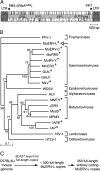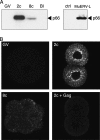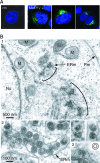Murine endogenous retrovirus MuERV-L is the progenitor of the "orphan" epsilon viruslike particles of the early mouse embryo
- PMID: 18045933
- PMCID: PMC2224431
- DOI: 10.1128/JVI.02097-07
Murine endogenous retrovirus MuERV-L is the progenitor of the "orphan" epsilon viruslike particles of the early mouse embryo
Abstract
Viruslike particles which displayed a peculiar wheellike appearance that distinguished them from A-, B- or C-type particles had previously been described in the early mouse embryo. The maximum expression of these so-called epsilon particles was observed in two-cell-stage embryos, followed by their rapid decline at later stages of development and no particles detected at the zygote one-cell stage. Here, we show that these particles are in fact produced by a newly discovered murine endogenous retrovirus (ERV) belonging to the widespread family of mammalian ERV-L elements and named MuERV-L. Using antibodies that we raised against the Gag protein of these elements, Western blot analysis and in toto immunofluorescence studies of the embryos at various stages disclosed the same developmental expression profile as that observed for epsilon particles. Using expression vectors for cloned, full-length, entirely coding MuERV-L copies and cell transfection, direct identification of the epsilon particles was finally achieved by high-resolution electron microscopy.
Figures



References
-
- Bénit, L., N. de Parseval, J.-F. Casella, I. Callebaut, A. Cordonnier, and T. Heidmann. 1997. Cloning of a new murine endogenous retrovirus, MuERV-L, with strong similarity to the human HERV-L element and with a gag coding sequence closely related to the Fv1 restriction gene. J. Virol. 715652-5657. - PMC - PubMed
-
- Bernhard, W. 1958. Electron microscopy of tumor cells and tumor viruses; a review. Cancer Res. 18491-509. - PubMed
-
- Boeke, J. D., and J. P. Stoye. 1997. Retrotransposons, endogenous retroviruses, and the evolution of retroelements, p. 343-435. In J. M. Coffin, S. H. Hughes, and H. E. Varmus (ed.), Retroviruses. Cold Spring Harbor Laboratory Press, Cold Spring Harbor, NY. - PubMed
Publication types
MeSH terms
Substances
LinkOut - more resources
Full Text Sources

